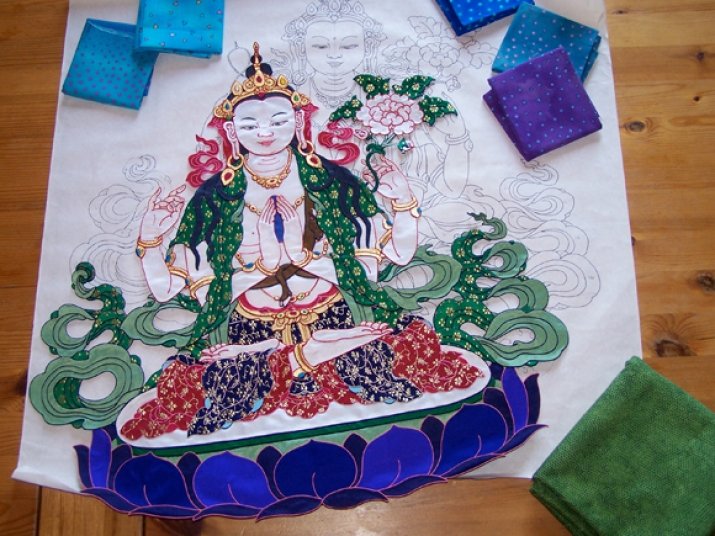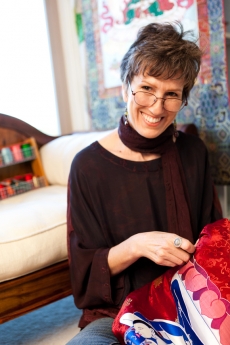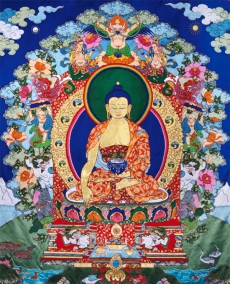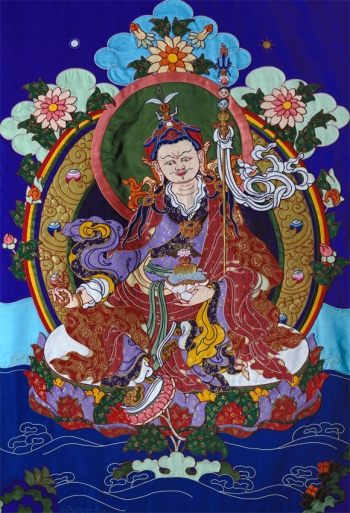Just over 20 years ago, Leslie Freilich left southern California to work in Dharamsala, India, as an economic development volunteer for Tibetan refugees. She was fascinated by Tibetan art and culture, and although a practicing Buddhist herself, admits, “I found it very hard to meditate.” As part of her job in Dharamsala she visited the atelier of a Tibetan artist, and fell in love with the Buddhist image that he was stitching. It was a silk mosaic depiction of the half-human, half-bird deity Garuda, and was formed by sewing together many small pieces of colored silk. Rich in color and texture, intricate in detail and profound in spirit, the image was to be mounted on silk as a thangka, a cloth image of a Buddhist deity that is typically painted with mineral pigments and gold. Freilich was aware that such paintings have long been used by Buddhist practitioners in rituals and meditation as visual aids in their pursuit of enlightenment, and they are frequently offered to temples as a means of acquiring religious merit. It was her encounter with the rarer pieced-silk thangkas (göchen thangka), however, that taught her the immense power that the creation of Buddhist imagery can have on the artist. It was by stitching her own thangkas that she finally learned how to meditate.
In Buddhist cultures, it is believed that making images of the Buddha and other deities can help focus the mind. For the small number of artists who have been creating pieced-silk thangkas since their invention in Tibet in the 15th century, the painstaking and very time-consuming process of building up an image of a deity out of pieces of silk is a form of artistic meditation. First they draw the figure, following the exact proportions of the deity as described in sacred Buddhist texts to ensure the deity’s spiritual power is preserved. Then individual elements of the design are cut out of different pieces of silk to form the face, the arms, the ribbons, and so on. Cords of horsetail hair wrapped in silk thread are couched onto the surface of these sections along precisely drawn lines, to create a raised outline. Next, the individual elements are placed like a jigsaw puzzle and carefully hand-stitched together. Many embroidered details are added along the way, the most important of which are the deity’s eyes, since it is through them that its spirit is transmitted. Finally, the image is framed in brocade and backed with cotton cloth for hanging.
After seeing the Garuda image in Dharamsala, Freilich knew immediately that she wanted to learn this complex spiritual art form. She approached an artist, T. G. Dorjee Wangdu, to ask if he would teach her. Although she spoke very little Tibetan at the time and he had never taught a non-Tibetan before, he agreed to take her on, and she apprenticed with him for four years. She completed her apprenticeship in 1997, and received the Buddhist name Leslie Rinchen-Wongmo. Since then, there has been little distinction for her between her religious and artistic practice, and her creation of these complex, detailed images from pieces of silk has served her as a form of meditation. Over the years, she has sat for many hours on end creating her sacred images—the Medicine Buddha, who sits holding medicine that can heal spiritual ailments, Padmasambhava, the father of Tibetan Buddhism, Green Tara, the compassionate goddess who is ready to help anyone suffering at a moment’s notice. Each image takes months to complete. People tell her that they wouldn’t have the patience to do what she does. “You don’t need patience if you love what you are doing,” she replies. That is the secret of meditation—finding a place in your mind that is so peaceful and comfortable that you can lose yourself in it. “In making fabric thangkas,” she explains, “I’m immersed in an ancient river of insight that flows from Buddha Shakyamuni through countless spiritual masters, accomplished artists, and simple tailors.”
Now an established artist, Rinchen-Wongmo has decided to pass her skills on to others, and she does so from a virtual atelier, instructing students all around the world using such modern tools as PDF files, webcams and teleconferencing via Skype. From the Buddha’s first sermons on a hilltop to Buddhist art classes on a laptop, it seems that the spiritual world is quite compatible with the virtual one. Rinchen-Wongmo, who is based in California, currently has 15 students enrolled in her “Stitching Buddhas” program from the US, Europe, Australia, and even as far north as Nunavut in Canada. Once they enroll, they receive monthly lessons via PDFs and then check in regularly via the internet to discuss their work. Despite being taught this art form via the internet, her students still pick up its spiritual qualities and power. “Students tell me that this work makes them more attentive and aware, and that that awareness spreads to other areas of their lives,” says Rinchen-Wongmo.
They each begin with a lotus, symbolizing our own pure Buddha nature, free from the mud and dirt of the material world; one student who has been working with her for over six years is now creating her second image of a Buddha. Her Australian student, Kerryn Coombe, who works as a counselor, recently claimed, “My stitching work is as much a part of my spiritual practice as my meditation and Dharma rituals.” Donna Weintraub from Newton, Massachusetts, claims that the program has been a path of learning about being present. “Each stitch, like each breath, is, in a sense, the most important one,” she explains. “When I become distracted from the stitching, it is evident in the completed piece; when I become distracted in being present in my life, all kinds of tangles and messes occur!”


















